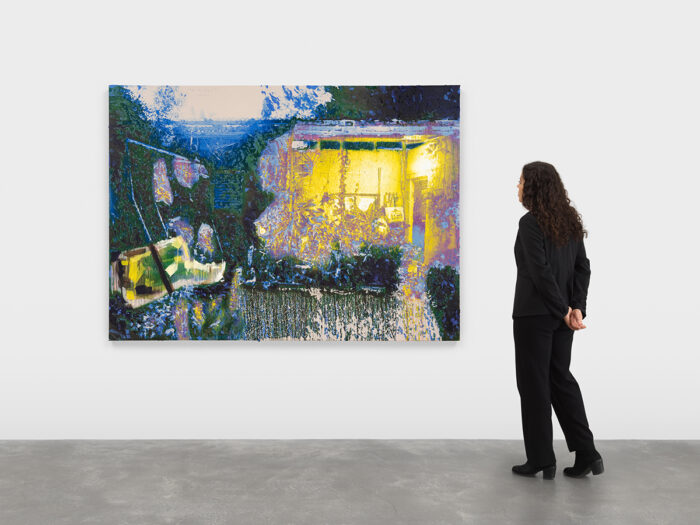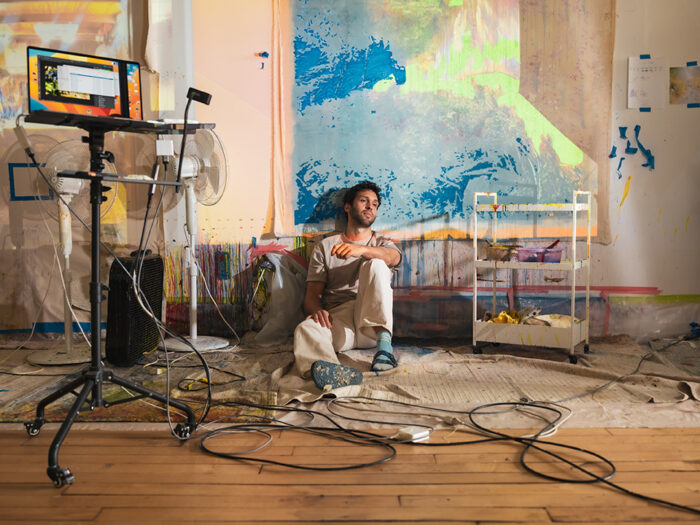
Definitionally, we think of the painter as the person who paints—a painter is the one who holds the brush and enacts their singular confluence of technical talent and conceptual vision onto the canvas. We assume that a painter, in all their specificity, is indispensable to the production of the painting. Modernity has certainly brought artists who play at the margins with the status of the painter: those who forgo technical ability in the name of conceptuality (or even the inverse). Yet, the painter has always remained a central figure.
Alexandre Lenoir is the rare artist who brings into question the relation a painter has to their painting—he manages to redefine what it means to be a painter. I was interested in speaking to Lenoir not only because of his artwork—blended, almost watery subdued colors and anonymized images that remind one of barely recalled memories—but also his process. He has a fascinating approach to relinquishing control that severs the painter from those who physically execute the paintings. He develops plans (what he calls “protocols”) that detail the production of the painting, and then, using photographs from his own life projected onto a canvas, studio assistants complete the paintings. Through this procedure, Lenoir paradoxically exerts control over a technique dependent on a lack of control. The painter is no longer the one who paints.
I spoke to Lenoir before his September 6th solo exhibition, Between dogs and wolves, at Almine Rech to discuss the process of his art, the function of remembrance, and what it means to be a painter.
Teddy Duncan Jr.: Broadly, the way I understand your artistic process is this: You develop things called “protocols,” which is how you want the paintings executed, and then you have a team of assistants who enact the protocols onto a canvas with a projected image on it. Then, at the end, after they work on the paintings for some months, you make the finishing touches. Is this accurate? How did you come to this process?
Alexandre Lenoir: You actually have the most important thing, which is that I give a protocol, an idea, and make this idea connect to material through people. When I first began painting, I was a bit concerned about the fact that only a painter can paint—this seemed elitist to me. I didn’t like the fact that I could only make a painting by myself with my own skills. I wanted to make a painting that could be made by everyone but with my insights, like an architect, a chef, or an orchestra conductor. I give movements that everyone can do. I give rules, and you just need to apply them. This puts the human in a very choreographic relation to the painting, and I’m just here to make sure that the protocol is well done. In a way, it is still my painting, but anyone can apply my protocol. And while it is controlled, it is an act of faith in those making the gestures.

Teddy: How many people work on the technical side of the painting in terms of executing the protocol?
Alexandre: There are three people in France and two people in New York. There are two studios, and for every painting, there is one person. I love giving one painting to one person because it is the same gesture for a month—it becomes very choreographic. At first, the protocol can be quite difficult to understand because there are a lot of details, but after a few days, it is like a dance.
Teddy: Are the ones who work on the paintings given any discretion? Do they need to adhere exactly to the precise instructions, or are they given a certain range of creative freedom with the protocols?
Alexandre: They don’t have any area where they can contribute something outside of applying the protocol. I don’t ask them to paint what they want on the canvas—for now. Maybe this will change in the future. For now, it is only my instructions that they follow. But I can tell you that I tried something else in Casablanca. I was living there for two years, and I had a team painting under my watch. After that, I told them to do what they wanted to do and told them to choose the image for the painting. It was a crazy experience because, in the end, I could not recognize what were my paintings, and which were not my paintings. Right now, I’m happy with giving instructions with a lot of control, but I’m always thinking about ways of giving up control.

Teddy: Your work features scenes from your life, and the process seems closely related to the functioning of memory. How do your paintings relate to the act of remembrance?
Alexandre: Indeed, there is a relation to memory and my process because memory is also about the transformation of an image. When you think of something, at the same time as thinking of it, the thing changes because of distance, time, and experience: things that you cannot control. The process of thinking of an image in your own mind and my process in the studio are, in a way, exactly the same. Removing myself allows some healthy distance from the work, offering an objectivity that I might not be able to capture myself. Memorial images are always elusive. So, I try to build an image with rules and documents but, at the same time, obliteration and disappearance.
Teddy: You use a variety of objects in your paintings, and in a video, your team was shredding blue tape and putting it on a canvas. What effect are you seeking by using different non-conventional objects for your paintings?
Alexandre: I started painting with my brush before I did the protocols, so it was the first step. At one point, I asked: ‘How can I represent something natural and not made by the human hand? How can I represent it in its essence, not with my skills but as it is?’ And I found this way of taping the canvas. You’re like a monk repeating the same gesture. It isn’t an artistic gesture; it’s very mechanical. It is something that anyone can do. It is a way for me to paint indirectly— without my skills.
I’m also representing something photographic but also emotive and linked to nature. I’m using as little brushstroke as I can and with as little intention as I can. The paintings are not perfect—I use very thin layers of water to make my paintings, and the water goes under the tape and dries. It is a very naturally driven way of painting. It creates something not directly made by my hand—it creates something linked to sedimentation.

Teddy: Do you think that your technique of rendering the artist as the one who constructs “protocols,” rather than the one who executes the plans, alters the position or status of the artist? In short, do you see your process redefining what it means to be a “painter”?
Alexandre: Painters can be a lot of different things, and I put myself in the lineage of painters who redefined what it means to be a “painter” by not painting directly with their brushes but by creating their own relation to the canvas. I think of Rudolf Stingel with all his ways of creating images, Pollock with his dripping, Christopher Wool with his erasement, Julian Schnabel when he paints with plates, Sol le Witt for his instructions, for example. They are, in a way, iconoclasts, not in the sense of the image but in the sense of what people think painting is and extend our relation to painting. For me, this way of painting came naturally to represent natural elements or distant memories in their essence.
